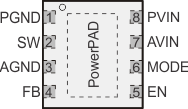SLVSA95B March 2010 – July 2015 TPS62060 , TPS62061 , TPS62063
PRODUCTION DATA.
- 1 Features
- 2 Applications
- 3 Description
- 4 Revision History
- 5 Device Comparison Table
- 6 Pin Configuration and Functions
- 7 Specifications
- 8 Detailed Description
- 9 Application and Implementation
- 10Power Supply Recommendations
- 11Layout
- 12Device and Documentation Support
- 13Mechanical, Packaging, and Orderable Information
Package Options
Mechanical Data (Package|Pins)
- DSG|8
Thermal pad, mechanical data (Package|Pins)
- DSG|8
Orderable Information
6 Pin Configuration and Functions
DSG Package
8-Pin WSON With PowerPAD
Top View

Pin Functions
| PIN | TYPE | DESCRIPTION | |
|---|---|---|---|
| NAME | NO. | ||
| AGND | 3 | I | Analog GND supply pin for the control circuit. |
| AVIN | 7 | I | Analog VIN power supply for the control circuit. Must be connected to PVIN and input capacitor. |
| EN | 5 | I | This is the enable pin of the device. Pulling this pin to low forces the device into shutdown mode. Pulling this pin to high enables the device. This pin must be terminated |
| FB | 4 | I | Feedback pin for the internal regulation loop. Connect the external resistor divider to this pin. In case of fixed output voltage option, connect this pin directly to the output capacitor |
| MODE | 6 | I | When MODE pin = High forces the device to operate in fixed frequency PWM mode. When MODE pin = Low enables the power save mode with automatic transition from PFM mode to fixed frequency PWM mode. |
| PGND | 1 | PWR | GND supply pin for the output stage. |
| PVIN | 8 | PWR | VIN power supply pin for the output stage. |
| SW | 2 | O | This is the switch pin and is connected to the internal MOSFET switches. Connect the external inductor between this terminal and the output capacitor. |
| PowerPAD | — | For good thermal performance, this PAD must be soldered to the land pattern on the PCB. This PAD should be used as device GND. | |